
by Somya Devi | Jul 26, 2019 | Astrology, Conjunctions, Planets Changing Signs, Retrograde
The Sun and Moon are getting closer and closer as we head towards a Dark Moon night this coming Wednesday. The New Moon in sidereal Cancer will be exact on July 31st at 8:12 pm PDT. This completes the previous lunar cycle which brought on the eclipses that affected many people in deep ways, especially those running dashas of Rahu or Ketu.
Cancer
The Cancer cycle could be a chance to cool down a little and come back into the heart after the heady and philosophical cycle of Gemini-Sag, with all the added eclipse energy. Cancer is the Moon’s sign, the sign of the Divine Mother and her nourishing waters. Spend time in a body of water this month, and connect with your own internal waters (feelings!) around this New Moon. Cancer is the fourth sign naturally, relating to the heart and the breasts, and is feminine or yin, helping us to direct our energy inwards.
Pushya Nakshatra
Within Cancer, the Sun and Moon are joining in the Vedic nakshatra called Pushya, meaning “the nourisher.” Symbolized by the udder of a cow, this star-sign gives a sense of abundance and sustenance. It can elicit a strong sense of family and responsibility, relating to both the divine mother and the divine father. Its deity is Brihaspati, a form of Jupiter who showed generosity and unconditional fatherly love in the story of how he adopted Mercury (a love child between his wife and the Moon). Fertility is strong under this star, and could be throughout this Moon cycle.
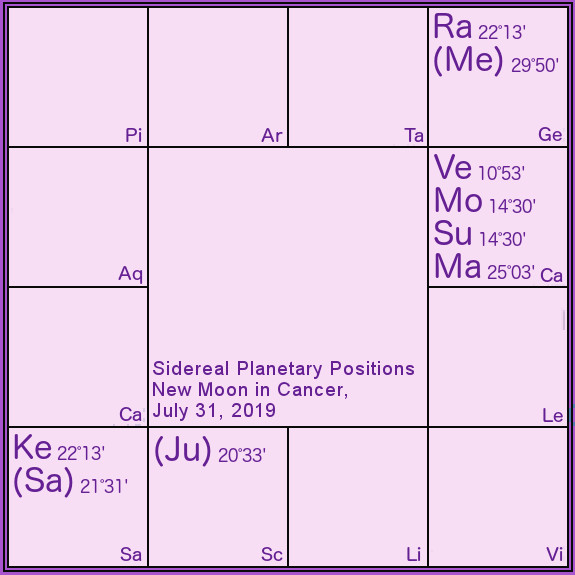
Mars Debilitated, Venus Combust
Mars is still traveling in Cancer, his sign of debilitation, for another week until he enters Leo on August 8th. Mars-ruled folks may feel their usual fight and fire is diminished, or that they’re needing more comfort and cuddling than normally.
Venus is also transiting through Cancer. He is already traveling fairly close to the Sun, but he’ll enter the highly combust zone (within 3 degrees), on August 3rd. With Venus so close to the Sun, we may find some of our worldly pleasurable pursuits feeling “burned up” by the purifying power of Surya. Relationships could be under a lot of pressure, or it may just be so hot where you are that it’s hard to enjoy anything. Venus reaches total combustion when he aligns with the Sun on August 14th, and won’t leave the 3-degree proximity zone until August 24th. (Looking at a 6-degree orb, Venus won’t leave combustion until September 4th.)
Jupiter Turning Direct
After several months, Jupiter is finally slowing down in his retrograde journey back through Scorpio, and will station and turn direct on August 11th. As he begins his journey forward once again, you’ll notice affects the most directly on the areas of life ruled by Jupiter in your chart, and depending on the unique placement of planets for you. In a general sense, we may notice things changing directions somewhat in the broader ideological field, as we have had a period of retrospection over principles and beliefs for the past several months.
Kala Sarpa Cycles
This New Moon finds all the planets in between the two nodes, on one side of the sky, creating a Kala Sarpa alignment. We’ll come under this alignment for half the month from now through December. When the Moon is on the same side of the nodal axis as the other planets, Kala Sarpa is on, and when he transits from Capricorn through Taurus, it is off. This can intensify the effects of the nodes, especially for those who have prominent nodal placements in the natal chart, or are running cycles of either Rahu or Ketu, bringing shadow work and intensity to the surface.
Mercury Turning Direct
Mercury is completely stationary at the time of this New Moon, turning “direct” less than an hour after the Sun-Moon conjunction. For those of you who have felt the Mercury Retrograde effects strongly this month, you can breathe a sigh of relief!
The next full Moon is on August 14th-15th.
This is a great time to have a personal reading– either an Initial Reading if this is your first time working with me, or an Eclipse Reading, if we have had a previous session, can help you to integrate the lessons that arose during the eclipse cycle.

by Somya Devi | Jun 3, 2019 | Uncategorized
Today begins the Taurus Moon cycle for this year, with Sun and Moon aligning exactly in sidereal Taurus early this morning (June 3rd) at 3:02 am PDT. In the fertile earth sign of Taurus, ruled by Venus, this dark Moon is inspired and uplifted in his sign of exaltation, while opposite a bright and graceful Jupiter.
Taurus Cycle
Taurus is the feminine earth sign ruled by the planet Venus. During the Taurus cycle, we may be more inspired to connect with the earth and the earthly elements around us. This is a good time for meditation with crystals and herbs, and utilizing gemstones and sweet juicy fruits as part of your offerings or remedies.
The dark Moon time is a good opportunity to hit the reset button each month. There may have been a lot of tensions building up throughout May due to Rahu and Mars together in Gemini, and the few days around the New Moon are a good time to cleanse and start a new cycle afresh. Sadhana will be important this month as well, as we are approaching an eclipse cycle in July.
Rohini
This Taurus cycle begins with Sun and Moon in Rohini nakshatra, “the reddish one.” The Moon’s nakshatra of exaltation, Rohini was said to be the favorite of the 27 “wives” he visited each month. There is a warm, nourishing, fertile energy here, ripe for beginnings of all sorts. The animal symbol of the male serpent also elicits sexual energy, while the symbol of the ox-cart relates to abundance through commerce.
Rahu and Mars
The two most aggressive planets are currently approaching each other in sidereal Gemini, as Mars makes his way forward and Rahu steadily creeps back through the degrees of this rashi. The last month may have brought up a lot of tense and aggressive communication, with a lot of harsh language in particular. This may be tempered now by Gemini’s ruler, Mercury, having joined the two malefics on June 2nd… But keep awareness of this conjunction over the next three weeks, especially on June 14th when Mars and Rahu come into exact alignment.
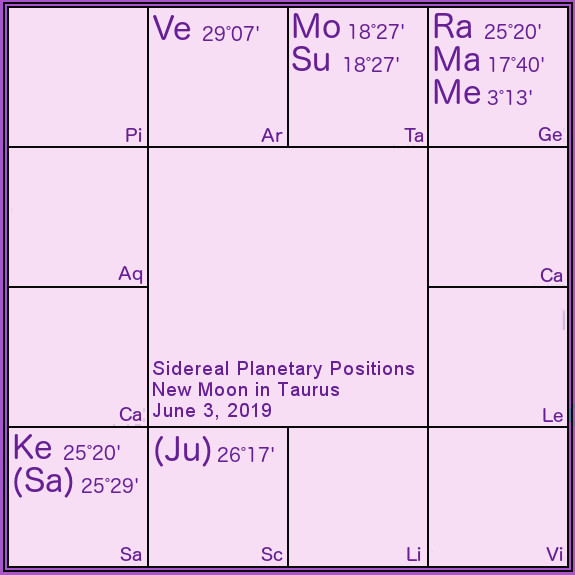
Eclipse Energy Building
We are now one month, one Moon cycle away from this summer’s eclipses. The first will be a Total Solar eclipse on July second, on the new Moon, with a partial lunar eclipse to follow on the full Moon of July 16th. Eclipse energy can usually be felt starting 2-4 weeks before the first eclipse of a set, so we may be experience the disruption already.
Eclipses are the times when the shadow grahas, Rahu and Ketu, become visible, and likewise our internal shadows begin to show themselves as well. Whatever areas of your life are located in Gemini and Sagittarius, this is where you are experiencing the nodal transit for a year-and-a-half. This is where you may feel disturbance over the next several weeks, as the eclipse energy stirs the pot and brings things to the surface that need your attention.
Time to offer that attention to what is arising! Challenges are what help us to grow, like when we break down muscle tissue exercising in order to rebuild it stronger. The imbalances in your life along the Sagittarius-Gemini axis are likely becoming harder and harder to ignore, as Rahu and Ketu shake the dust out of the corners. If we meet what is arising with mindfulness and a desire to grow, we can make new strides during eclipse season. But if we fight against the challenges and attempt to remain the same, eclipses can turn things in our lives upside down and bring more stress than necessary. Sadhana and prayer are especially helpful now.
Five Malefics Joining
The energy of this eclipse season is augmented by the conjunctions of Mars and Saturn with Rahu and Ketu, respectively. Four malefics are joining forces on the same axis—and when Sun moves into Gemini on the 15th, all five malefics will be together! The so-called “malefics” are the planets that offer us growth and blessings through challenge. They teach us the lessons of perseverence, discipline, self-awareness, and purification. As we embrace these we are able to gain the benefits of their light—longevity, strength, power, and mystic knowledge, to name a few.
Venus and Jupiter
Venus and Jupiter, along with Moon, are three so-called “benefic” planets, on the other hand, those that bring us their blessings usually through more pleasant intervention. Venus will be transiting into his own sign of Taurus later on June 3rd, bringing strength to the alignments at hand. During the polarized chart of the malefics all in alignment, the strong sva Venus will be opposite an incredibly bright and retrograde Jupiter.
Jupiter is getting brighter and brighter each day as he approaches “fullness,” or being directly opposite the Sun. A nearly full Moon will join him there on the nights of June 14th and 15th, bringing a lot of grace to balance the strong malefic alignments happening.
Personal readings are available and will help to explain how all of these alignments affect your chart in particular. Many interesting affects may be happening with such a concentration of energy in the sky.

by Somya Devi | May 2, 2019 | Astrology, Conjunctions, Holy Days, Planets Changing Signs
Sun and Moon join in sidereal Aries and bring a dark Moon night this Friday before their exact conjunction on May 4th at 3:46 pm PDT. At 20° of Aries, this New Moon begins a lunar cycle under Bharani nakshatra, the sign of birth, death, and rebirth. Aries ruler Mars is now joining Rahu, which adds volatility to this cycle. The Sun and Moon are nearly opposite the bright and retrograde Jupiter and Saturn, the latter of whom is having a close conjunction with Ketu now, and for the next several months.
Aries – Bharani Cycle
Aries is the sign where the Sun is exalted, meaning our collective health, energy, and sense of strength and power is well-supported at this time. That’s why the springtime in the north often brings us out of our shells, finding inspiration and ready to begin new projects. Aries has a birthing energy within itself, as it is the “let’s go” first sign of the twelve rashis.
Within sidereal Aries, Bharani nakshatra spans the middle section, associated with three bright hot stars in this constellation. This asterism brings a powerful fire energy, an element capable of creation and transformation. Bharani is symbolised by the yoni, the female reproductive organ, and translates as “the bearer.” There is a strong energy for birthing and creating that comes with a lunar cycle under Bharani.
Its Vedic deity, however, is Lord Yama, the god of death. This reminds us that all that begins must eventually end, and in Vedic thought, is then reborn again in a new form. Bharani is known as the star of restraint, yet perhaps that is a lesson that we must strive to learn here, as it can be a very sexual and passionate star-sign. Saturn is debilitated here, showing that discipline and patience do not necessarily come easily.
Mars & Rahu
Mars will transit into sidereal Gemini two days after the New Moon, on May 6th, and join him for about six weeks. These two planets together can create a lot of power, and perhaps violence. Mars has a strong warrior energy, which can be very disciplined with a healthy Mars, while Rahu has the aggressive and forceful energy of an army but without the discipline, or even self-awareness. If you are challenged by Mars in general, are hot-headed, or impulsive, be very aware that these qualities can be heightened during this conjunction.
Mars and Rahu will be joining from now through June 22nd. The volatility may be mitigated, however, after June 1st, when Mercury also joins them in Gemini. Being joined by a dispositor or ruler-of-the-sign can help to stabilize planets and assuage some of the malefic affects.
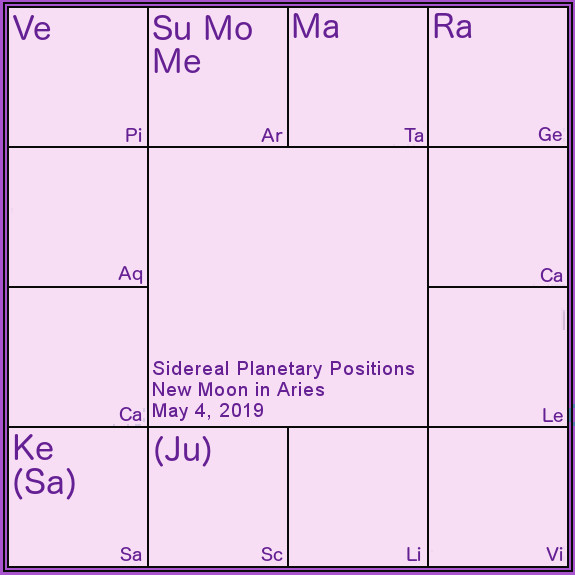
Retrograde Jupiter
Jupiter is now in apparent retrograde motion and has transited back into Scorpio from his short jaunt in Sagittarius. On May 6th, he’ll move just past 29°12’ of Scorpio, leaving the heart of the gandanta area (the karmic knot), which may have had us feeling stuck in the Jupiter-ruled areas of your life. Jupiter retrograde is actually an incredibly bright and strong force. Now nearly opposite the Sun (and coming closer to exact opposition each day), he is getting brighter every night, and that auspicious glow can offer luck and prosperity.
Akshaya Tritiya
There is one particular day of the year that is revered as a day of abundance, auspicious for making investments and starting new ventures. This day is Akshaya Tritiya, is the “third” day of the lunar cycle begun in Aries (it will span from May 6th-7th this year, PDT). It is known as the day of “never diminishing,” hence auspicious for beginning or cultivating that which you would like to grow. People often buy gold or silver, even homes or vehicles, or launch new ventures at this time.
Akshaya Tritiya is auspicious because it is the one lunar phase all year where both the Moon and the Sun are exalted. The Sun is exalted in Aries, while the Moon is exalted in Taurus, Venus’ fertile earth sign. While the body and the active energy principle within can shine with creative strength, the Moon and the feminine principle can rest and be fulfilled.
Retrograde Saturn & Ketu
Saturn stationed and began his retrograde journey on April 29th, just after coming within one degree of the always-retrograde Ketu. The two are now moving together at a snail’s pace, and will remain joined from now through October 1st. They will have exact conjunctions on May 20th, and then again on June 23rd. This conjunction may be taking a toll on the area of your life indicated by sidereal Sagittarius, or at least causing a lot of stress and worry there. Saturn pressures us to think about the big picture, especially our responsibilities, while Ketu compels us to let go of a lot we have held close. Melding these two impetuses will require a determined, and discerning, spiritual focus.
Exalted Venus
Venus remains exalted in Pisces for a few more days, until he transits into Aries on May 10th. As Bharani’s planetary ruler, this enhances the feminine creative energy we find as we begin this new Moon cycle.
To see how these transits affect your chart specifically, join me for a personal chart analysis based on your birth time and place.

by Somya Devi | Apr 3, 2019 | Astrology, Conjunctions, Eclipses, Events, Holy Days, Planets Changing Signs, Retrograde
The Sun and Moon come together to begin a new lunar cycle at 1:51 am PDT on April 5th. They will join in sidereal Pisces in the nakshatra called Revati, the last of the 27 star signs of Jyotish. This New Moon brings with it the springtime nine-night celebration of the goddess, known as Chaitra Navaratri. Though often less celebrated than the fall-time equivalent, this holiday is an important counterpart as we recognize the blooming of the life cycle, made possible by the sacred divine feminine.
Pisces Cycle
The Dark Moon will be in sidereal Pisces, at 21°. (If you aren’t familiar with the sidereal/star-based vs. tropical/seasonally-based zodiacs, review my article here!) Pisces is the last of the twelve major signs, and thus relates very much with letting go, especially on the materially plane, and surrendering to spirit or a higher power. Ruled by Jupiter (literally “Guru” or the teacher), the Pisces cycle will help us to get more in touch with our highest values and philosophies. As a water sign, we are also more intuitively driven this month. Your dreams and visions can reveal a lot during this cycle, and inward reflection and meditation can be potent on this Dark Moon (April 4th-5th).
Revati
In addition to being in the final rasi, this New Moon is also in the final nakshatra, the Vedic signs that the Moon visits for one moon phase each, each month. Meaning “the wealthy,” this sign brings grace, kindness, and compassion. It is ruled by the deity Pushan, the celestial shepherd who provides nourishment and protection, both to herds (of animals) and also to people on safe journeys. This star often brings a love of animals and people with a natal Moon here often work with animals or have strong relationships with pets. The actual animal symbol is the female elephant, another auspicious symbol in India.
 Chaitra Navaratri
Chaitra Navaratri
After the Dark Moon night, the first nine nights of this cycle will be the springtime Navaratri celebration, in the Hindu month of Chaitra. The nine nights are a time to get in touch with the Goddess energy, apparent and emergent as we enter the spring season in the northern hemisphere. There are so many forms to the goddess, and she truly offers us an immense well of abundance through all facets of life. This is a good time to get clear on what you are calling in, and trying to manifest with the grace of the goddess by your side.
Recent Nodal Transit
The nodes on all counts are officially transiting Gemini and Sagittarius now, with Rahu in Gemini and Ketu in Sagittarius. This new nodal cycle will last until September of 2020. Whichever houses these are in your chart will be effected, especially around the times of the eclipses, this July, December-January, and next June-July.
Saturn & Ketu
Not only is Ketu in Sagittarius, but he is approaching a close conjunction with Saturn. This could pile up a lot of stressful energy in the area of your life indicated by Sagittarius, unfortunately for most of this year. They’ll be joining within one degree (mean node calculation) at the end of this month, on the 25th, as Saturn slows to a halt and begins retrograde motion on the 29th. Since Ketu is always “retrograde,” the two will then be traveling together through the whole summer, until Saturn turns direct on September 18th, and they finally break their one-degree proximity on October 1st.
How will this affect us? It’s difficult to say exactly because they have somewhat conflicting energies… thus you can expect to feel this type of push-pull conflict in the Sagittarius area of your life. Saturn puts on the pressure, makes us do the hard work to meet our goals, have patience, and endure. On the other hand, Ketu often compels us to throw our hands up and renounce the task at hand, feeling so critical of it that we often want to let it go completely. We can dive into an exploration of this transit over your personal chart in an Eclipse Reading.*
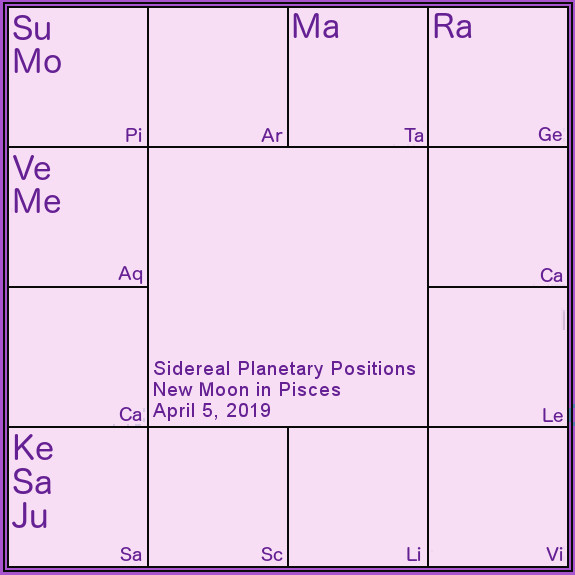
Jupiter & Venus
Jupiter is also joining Saturn and Ketu in Sagittarius now, hovering in the early gandanta degree as he slows to a stop and begins retrograde motion on April 10th. This will send him back into Scorpio on the 22nd. His presence in his own sign of Sagittarius could normally be uplifting to the situation there, but in his current condition he may not be as helpful as usual. The gandanta energy could make him weaker, while the retrograde condition is actually a strength (he will be quite bright in the sky in the coming months). Remember that he is also the ruler of this Pisces new Moon, so this “mixed” stuck/inspired energy could also seep into the general tone of the month ahead.
Venus will be moving into Pisces on the 15th, however, where he is exalted, which could bring some upliftment and more happiness into our lives, though he will also be conditioned by the mixed opportunities that Pisces’ ruler Jupiter offers right now.
*If this is your first reading with me, I recommend starting with the longer life-course reading, which will include a look at the current transits and how these affect you, in addition to your general karma, strengths, and challenges.
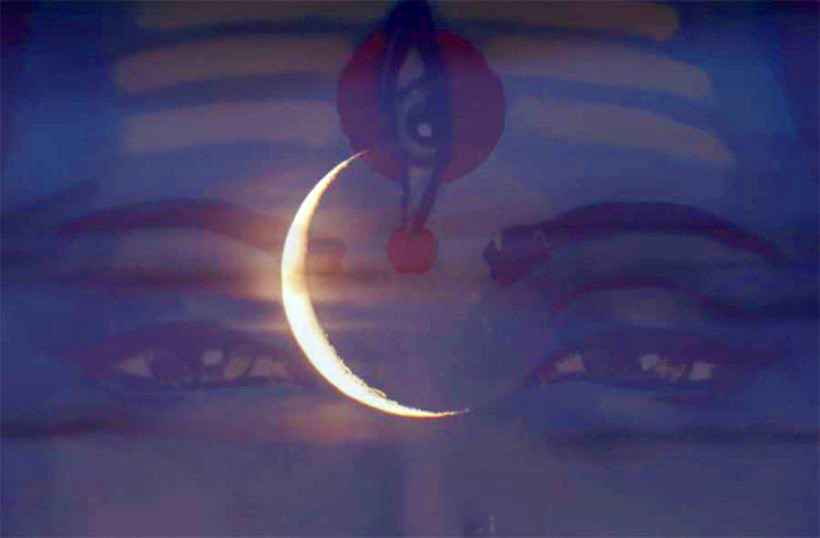
by Somya Devi | Feb 28, 2019 | Astrology, Conjunctions, Holy Days, Planets Changing Signs, Retrograde
The Moon wanes in sidereal Aquarius on the dark night of March 5th, approaching the exact Sun-Moon alignment for a New Moon at 8:04 am on Wednesday, March 6th, beginning a new lunar cycle. Leading up to this will be Maha Shivaratri, “the great night of Lord Shiva,” on March 4th. This is an auspicious night for prayer and penance, and the benefits of sadhana are multiplied by the Moon’s position and the collective vibration.
Maha Shivaratri
Monday night, March 4th, the night prior to the Dark Moon night, is the fourteenth waning phase of the lunar cycle. During this month this night is celebrated as Maha Shivaratri. This is perhaps the most auspicious night of the year for doing sadhana (spiritual practice). It is traditional on this night to stay up all night fasting, chanting, praying, and meditating. This holiday honors Lord Shiva, the great ascetic, and we can recall two stories of great sacrifices that he made protect the entire creation.
One of these is the story of the churning of the milk ocean, which the gods and demons were doing in order to release the nectar of immortality. Before the nectar came up, however, a poison came up first. (This is similar to when we do spiritual practice and begin our path of self-inquiry, and negative tendencies often come to light first, which can be a painful experience. Similarly, during a physical fast or cleanse, toxins can be shaken loose and released first, causing a healing crisis before we continue healing into a freer, happier state of being.) When the poison came up from the milk ocean, Lord Shiva consumed it so that it would not engulf humanity, as a great and noble sacrifice. His wife, Parvati, however, held his throat so that he could not ingest it, thus saving him from being harmed by the poison.
Maha Shivaratri also commemorates the wedding of Shiva and Parvati, which also stemmed from great sacrifice made for the benefit of all humanity. It was said that after his first wife, Sati, perished, Shiva was fully devoted only to his sadhana, meditating for aeons in isolation and renouncing the world. Then the demon Tarakasura began running amock on earth, threatening all of humanity. Brahma foretold that only Shiva’s child could defeat Tarakasura, so the gods devised a plan for Sati to reincarnate as Parvati, and win over her Lord to marriage once again. He was not easily swayed, however, and it was only after Parvati became an ascetic and underwent great penance that he agreed to marry. They eventually produced their son Kartikkeya, who went on to slay the demon.
Thus, this holiday is celebrated through the penance of fasting, forgoing food, water, and sleep, for one night, and simultaneously celebrating the union of Lord Shiva and Parvati, or the masculine and feminine energies of creation, that allows this dance of life to continue. It is an apt time to feel the forces of Aquarius upon us, which compel us to consider our role in society, and in the universe, and what personal sacrifices we can make for the greater good. Even if you’re not able to stay up the whole night, any amount of devotional practice, serviceful sacrifice, or chanting of Om Namah Shivaya on this night can have beneficial affects that are magnified greater than on any other night.
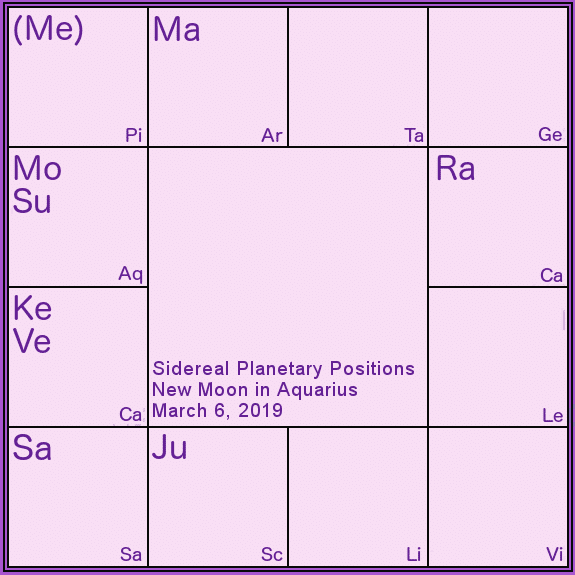
Aquarius Moon Cycle
The Sun and Moon meet in sidereal Aquarius to begin this lunar cycle. Aquarius is known as Kumbha in Sanskrit, a word for “pitcher” or “vessel.” According to the Vedic texts, the sign Kumbha can be imagined as a man holding a pot, with deep-brown skin, standing in the water. We can see this Aquarian imagery in the sadhus of India (and its biggest ritual pilgrimage day, the Kumbha Mela), who make their lives an offering of service to society through their prayers and Saturnian austerities, while renouncing the individual self. In the Aquarius cycle, we think about how we can serve the whole.
Saturn both rules Aquarius and is aspecting the Sun and Moon here (from sidereal Sagittarius) at the time of this New Moon. Saturn brings to us awareness of the long term and the bigger picture, and through this masculine or active sign, compels us to make commitments and offerings to something greater than ourselves and our momentary happiness. This is a great month to consider a new way that you may be of service to your community or to society.
Purva Bhadrapada
The New Moon cycle begins with the Sun and Moon in the Vedic nakshatra called Purva Bhadrapada, the former “lucky footed one.” This nakshatra bridges Aquarius and Pisces and is often represented by a funeral cot, symbolizing the transition from life into death, or ultimate liberation. It is ruled by Aja Epakada, the one-footed goat who is often associated with the image of Lord Shiva as Nataraj dancing on one foot, a fitting image for Maha Shivaratri.
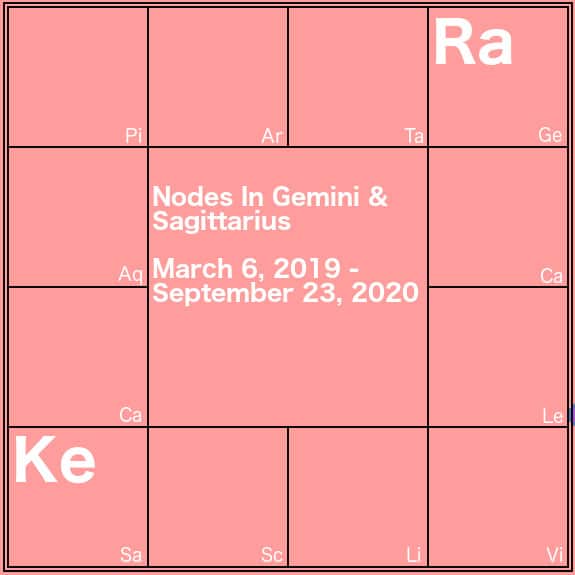 Nodes Are Changing Signs!
Nodes Are Changing Signs!
With a mean node calculation, Rahu and Ketu will transit into Gemini-Sagittarius on March 6th. (Under a true node calculation, they will not change signs until March 23rd; See Technicalities: Mean vs. True Node section below if you want a little more info about nodal calculations.) Regardless of the calculation used, March is a month of transition for the nodal energy. With the nodes in Cancer-Capricorn for the last year-and-a-half, we collectively felt a dichotomy between listening to the heart and following our emotions, against doing what is practical and responsible in an earthly way. It was a chance to balance these two things as well, learning to create a harmony between the practical and the emotional.
Throughout the coming transit of Rahu and Ketu through Gemini and Sagittarius, we will be feeling a polarization between curiosity, fact-finding and learning in an intellectual way, versus taking actions based on our principles and beliefs. Sometimes the intellectual mind does not agree with our fiery passions. This transit will be a time to learn to balance the two. With opinionated Sagittarius on one side, and communicative yet flexible Gemini on the other side, we may learn new ways to communicate and interact with those who oppose us in ideas, stepping into another’s shoes while still maintaining and honoring our personal beliefs and philosophy.
For each natal rising sign, this coming transit will affect a particular axis of learning in your life. You will be more able to see and work with some of your blind spots in these areas throughout the coming year-and-a-half long nodal transit. These things will especially surface around the bi-annual pairs of eclipses (coming this year in July and December).
Mercury Retrograde
Mercury stations and begins apparent retrograde motion on March 5th, the day before the New Moon. He is also currently debilitated in sidereal Pisces, so this time period could have us a bit mixed up around some details, and possibly challenged with communication and accuracy. He’ll retrograde back into Aquarius on March 14th, before returning to direct motion on the 28th.
Jupiter Gandanta
Also during the first half of this lunar cycle, Jupiter will enter the last 48 minutes of sidereal Scorpio (one muhurta), on March 15th. This region of the sky, called gandanta or a “knot,” is considered one of the most difficult places in the zodiac. It spans for one muhurta before and after the 0° point between sidereal Scorpio and Sagittarius, as well as those regions on the cusp of Cancer-Leo and Pisces-Aries (however, this gandanta location is often considered the most difficult. (Some astrologers may consider it spanning up to one or even two or three degrees to either side of the cusps.)
Normally, a planet transits through this zone rather quickly. Jupiter is currently slowing down, however, and will come to a stationary halt at 0°14’ of sidereal Sagittarius on April 10th, before beginning retrograde motion and passing back into Scorpio. He will threrefore be traveling the gandanta zone all the way from March 15th until May 6th (or longer if the zone is interpreted as wider).
Though Jupiter will be dipping into his own sign from March 15th through April 22nd, the fact that he will remain in gandanta at this time will not bring the added strength that we would expect from a sva graha. Those who are ruled by Jupiter may feel a bit “stuck” in various ways throughout this transit. It is important to be patient and keep up with sadhana during this time. Additionally, he will be joined by both Saturn and Ketu during his time in Sagittarius, both of which can be challenging companions.
Technicalities: Mean vs. True Node
Rahu and Ketu have been transiting through the Cancer-Capricorn axis for nearly 18 months, and are getting ready to make their transition into the Gemini-Sagittarius axis, for the next 18. The date of this transition will vary whether you are using the “mean node” calculation or the “true node” calculation. To simplify this as much as possible, we must realize that the nodes do not have planetary bodies that can be observed as the other grahas can be. (The grahas are “the forces that grab us,” including the Sun, Moon, Mars, Mercury, Jupiter, Venus, Saturn, Rahu and Ketu.)
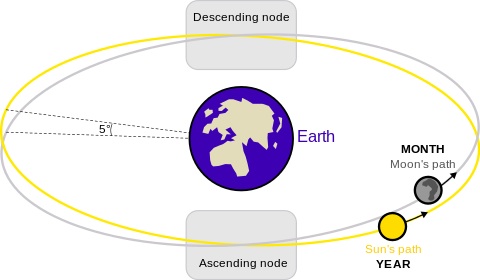 The nodes, astronomically are the places where the Sun’s and Moon’s paths intersect. The ecliptic is the apparent paths that the Sun travels “around” the Earth. The Moon’s orbits is not completely flat or parallel with the Sun’s, but slightly inclined, so that it passes this line and is sometimes to the north of it, sometimes to the south. We can measure astronomically and by observation when these crossings happen. To get the mean node, we take an average distance between these two points based on how many days it takes the Moon to get from one to the other. The true node is calculated using a method that also accounts for the slight wobble of the earth and the Moon’s orbit around it.
The nodes, astronomically are the places where the Sun’s and Moon’s paths intersect. The ecliptic is the apparent paths that the Sun travels “around” the Earth. The Moon’s orbits is not completely flat or parallel with the Sun’s, but slightly inclined, so that it passes this line and is sometimes to the north of it, sometimes to the south. We can measure astronomically and by observation when these crossings happen. To get the mean node, we take an average distance between these two points based on how many days it takes the Moon to get from one to the other. The true node is calculated using a method that also accounts for the slight wobble of the earth and the Moon’s orbit around it.
Some astrologers favor using the “mean” node calculation while others prefer the “true.” These two calculations of the node will sometimes put them about one degree apart, which is noticeable in cases where, in a natal chart, someone’s node is on the cusp of two signs (it may be in one sign using mean node and another sign using true node). It also affects the date of transition between signs that we observe when talking about nodal transits. In both cases, it is best to observe for yourself (use a lot of charts for case studies) and see which makes the most sense to you. I prefer using mean node calculation.
Personal Readings are available to help you understand your individual natal chart and how these transits will affect your upcoming year.













